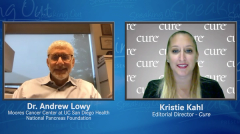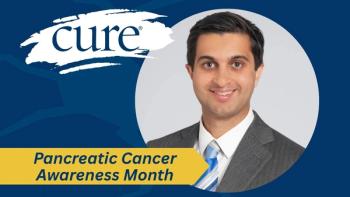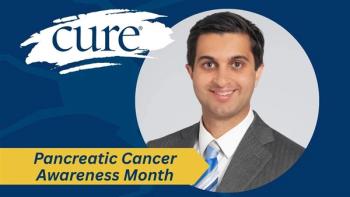
Basics of Pancreatic Cancer
Kristie L. Kahl: Can you explain the pancreas and how this type of cancer begins?
Dr. Eileen O’Reilly: The pancreas is an organ that sits in the back of the abdomen, it's sort of a banana-shaped organ in the midline over to the left. And it has two major functions. It produces a variety of hormones that control blood sugar, the main one being insulin, but also others. And it produces some enzymes that break down and digest what we eat. So those are the two main roles of the pancreas. Most people aren't so aware of this organ until it's affected either with diabetes, inflammation, pancreatitis or the cancer.
Kristie L. Kahl: What is the rate of pancreatic cancer diagnoses each year in the United States?
Dr. Eileen O’Reilly: So about 57 58,000 people will be diagnosed with pancreas cancer in 2020. And we've seen a steady increase in the incidence of this disease over the last number of decades, about a half a percent increase per year. And that's a worrisome trend. It's a disease of older people. But the other kind of worrisome trend is the incidence in older people is flat, but we're seeing an increase in incidence in younger people. And that may be partly related to some lifestyle considerations related to diabetes and related to obesity.
Kristie L. Kahl: Can you discuss the types of pancreatic cancer?
Dr. Eileen O’Reilly: There are a number of different types of pancreas malignancy, the most common is adenocarcinoma, or how most people refer to as pancreas cancer. And adenocarcinoma rises in a duct or gland and other carcinomas can arise anywhere in the body, but major percentage of pancreas malignancies are no carcinoma. The next most common type is neuroendocrine cancer, and they tend to be a little different in their behavior, and sometimes more slow growing and can exist over a very extended period of time. And then there are a number of rare types of pancreas malignancy that are a couple of percent or less, and treatments and how they're approached is individualized, but they're mostly addressed from the surgery perspective.
Kristie L. Kahl: Can you discuss the different stages of pancreatic cancer?
Dr. Eileen O’Reilly: So pancreas cancer, there are two stages: clinical staging and pathologic staging. To explain that clinical staging is how we interpret the disease when a person hasn't gone to the operating room. So a person with localized pancreas cancer confined through the glands that's amenable to an operation would be potentially operable or resectable. The next stage is stage 3, which is locally advanced meaning involving key blood vessels, but not operable. And stage 4 is metastatic disease with the common areas of spread being liver, long, inner lining of the abdominal cavity, lymph nodes, and then rarer systems like bombs. So that's clinical staging. pathologic staging applies to those who undergo surgery. So where one has the opportunity to examine the tissue directly. And there we look at the size of the tumor, whether there are lymph nodes involved, and then the stage in that context, so most people who undergo surgery and have their cancer removed, will have either stage 2 that's most common with lymph node involvement, or sometimes stage 1.
Kristie L. Kahl: Pancreas cancer is often diagnosed at an advanced stage, unfortunately, why is that?
Dr. Eileen O’Reilly: So this is a very common, very important thing. Pancreas cancer, as we often discuss in the clinic is the ultimate sneaky business right in terms of how it manifests. It's relatively silent until it has reached a critical mass in the body and causes symptoms. And we have models to suggest that the first cancer cells develop many years prior to the onset of symptoms. And symptoms when they do occur can be for some people relatively nonspecific, and not point in a specific diagnosis direction. For others, they can prompt medical attention. And so to explain that a little further, tumors that arise in the head of the pancreas, which is the most common area, tend to cause jaundice, because they blocked about it. And that causes yellowing of the eyes, solidness of the skin, dark urine and sometimes itching, and that will prompt people to seek medical attention. Whereas tumors that are in the body or the tail, so to the left side of the midline, it can be annoying, or an interesting back discomfort, sort of subtle changes in appetite and energy, but often not as big a prompt to seek evaluation. And that may be part of it. the biology of this disease, how the cells grow and develop is also part of this, that these cancer cells can have a high propensity to early spreads, relative, for example, to other cancers. And that may be part of the reason, when we do diagnosis that for many, the cancer is not amenable to surgery, certainly treatable, but it's either involving blood vessels, or has spreads beyond the pancreas.
Kristie L. Kahl: Why is it so important to raise more awareness around pancreatic cancer?
Dr. Eileen O’Reilly: Thank you for this question. It's a really important question. And advocacy organizations such as the National Pancreas Cancer Foundation serves a major role here in highlighting this disease and increasing awareness about this cancer, highlighting the symptoms that an individual can present with and to encourage them to seek medical attention. I think highlighting that this cancer may not be curable for many, but it is treatable. And that's an important message to emphasize because there is typically a lot of understandable naturalism regarding treatment of this disease. And that's something that we really need to change. And that, in particular, if this cancer can be diagnosed early, and we already know this, that earlier diagnosis improves outcome. So awareness, prompting, assessment with symptoms, especially for subgroups of people that might be more at risk for this disease is likely to impact outcome. And I think the other reason the national pancreas cancer, national pancreas foundation plays a very important role is that having more people focused on this disease in terms of research, right, will help improve outcomes. Just raising awareness, funding, extremely key considerations.





